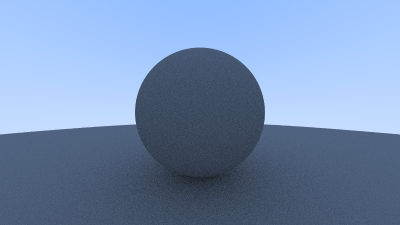Fixing Shadow Acne
There’s also a subtle bug that we need to address. A ray will attempt to accurately calculate the intersection point when it intersects with a surface. Unfortunately for us, this calculation is susceptible to floating point rounding errors which can cause the intersection point to be ever so slightly off. This means that the origin of the next ray, the ray that is randomly scattered off of the surface, is unlikely to be perfectly flush with the surface. It might be just above the surface. It might be just below the surface. If the ray's origin is just below the surface then it could intersect with that surface again. Which means that it will find the nearest surface at \( 𝑡 = 0.00000001 \) or whatever floating point approximation the hit function gives us. The simplest hack to address this is just to ignore hits that are very close to the calculated intersection point:
diff --git a/src/camera.rs b/src/camera.rs
index 2abb78e..eea2b1f 100644
--- a/src/camera.rs
+++ b/src/camera.rs
@@ -1,166 +1,166 @@
use crate::{hittable::Hittable, prelude::*};
pub struct Camera {
/// Ratio of image width over height
pub aspect_ratio: f64,
/// Rendered image width in pixel count
pub image_width: i32,
// Count of random samples for each pixel
pub samples_per_pixel: i32,
// Maximum number of ray bounces into scene
pub max_depth: i32,
/// Rendered image height
image_height: i32,
// Color scale factor for a sum of pixel samples
pixel_samples_scale: f64,
/// Camera center
center: Point3,
/// Location of pixel 0, 0
pixel00_loc: Point3,
/// Offset to pixel to the right
pixel_delta_u: Vec3,
/// Offset to pixel below
pixel_delta_v: Vec3,
}
impl Default for Camera {
fn default() -> Self {
Self {
aspect_ratio: 1.0,
image_width: 100,
samples_per_pixel: 10,
max_depth: 10,
image_height: Default::default(),
pixel_samples_scale: Default::default(),
center: Default::default(),
pixel00_loc: Default::default(),
pixel_delta_u: Default::default(),
pixel_delta_v: Default::default(),
}
}
}
impl Camera {
pub fn with_aspect_ratio(mut self, aspect_ratio: f64) -> Self {
self.aspect_ratio = aspect_ratio;
self
}
pub fn with_image_width(mut self, image_width: i32) -> Self {
self.image_width = image_width;
self
}
pub fn with_samples_per_pixel(mut self, samples_per_pixel: i32) -> Self {
self.samples_per_pixel = samples_per_pixel;
self
}
pub fn with_max_depth(mut self, max_depth: i32) -> Self {
self.max_depth = max_depth;
self
}
pub fn render(&mut self, world: &impl Hittable) -> std::io::Result<()> {
self.initialize();
println!("P3");
println!("{} {}", self.image_width, self.image_height);
println!("255");
for j in 0..self.image_height {
info!("Scanlines remaining: {}", self.image_height - j);
for i in 0..self.image_width {
let mut pixel_color = Color::new(0.0, 0.0, 0.0);
for _sample in 0..self.samples_per_pixel {
let r = self.get_ray(i, j);
pixel_color += Self::ray_color(r, self.max_depth, world);
}
write_color(std::io::stdout(), self.pixel_samples_scale * pixel_color)?;
}
}
info!("Done.");
Ok(())
}
fn initialize(&mut self) {
self.image_height = {
let image_height = (self.image_width as f64 / self.aspect_ratio) as i32;
if image_height < 1 { 1 } else { image_height }
};
self.pixel_samples_scale = 1.0 / self.samples_per_pixel as f64;
self.center = Point3::new(0.0, 0.0, 0.0);
// Determine viewport dimensions.
let focal_length = 1.0;
let viewport_height = 2.0;
let viewport_width =
viewport_height * (self.image_width as f64) / (self.image_height as f64);
// Calculate the vectors across the horizontal and down the vertical viewport edges.
let viewport_u = Vec3::new(viewport_width, 0.0, 0.0);
let viewport_v = Vec3::new(0.0, -viewport_height, 0.0);
// Calculate the horizontal and vertical delta vectors from pixel to pixel.
self.pixel_delta_u = viewport_u / self.image_width as f64;
self.pixel_delta_v = viewport_v / self.image_height as f64;
// Calculate the location of the upper left pixel.
let viewport_upper_left =
self.center - Vec3::new(0.0, 0.0, focal_length) - viewport_u / 2.0 - viewport_v / 2.0;
self.pixel00_loc = viewport_upper_left + 0.5 * (self.pixel_delta_u + self.pixel_delta_v);
}
fn get_ray(&self, i: i32, j: i32) -> Ray {
// Construct a camera ray originating from the origin and directed at randomly sampled
// point around the pixel location i, j.
let offset = Self::sample_square();
let pixel_sample = self.pixel00_loc
+ ((i as f64 + offset.x()) * self.pixel_delta_u)
+ ((j as f64 + offset.y()) * self.pixel_delta_v);
let ray_origin = self.center;
let ray_direction = pixel_sample - ray_origin;
Ray::new(ray_origin, ray_direction)
}
fn sample_square() -> Vec3 {
// Returns the vector to a random point in the [-.5,-.5]-[+.5,+.5] unit square.
Vec3::new(
rand::random::<f64>() - 0.5,
rand::random::<f64>() - 0.5,
0.0,
)
}
fn _sample_disk(radius: f64) -> Vec3 {
// Returns a random point in the unit (radius 0.5) disk centered at the origin.
radius * random_in_unit_disk()
}
fn ray_color(r: Ray, depth: i32, world: &impl Hittable) -> Color {
// If we've exceeded the ray bounce limit, no more light is gathered.
if depth <= 0 {
return Color::new(0.0, 0.0, 0.0);
}
- if let Some(rec) = world.hit(r, Interval::new(0.0, INFINITY)) {
+ if let Some(rec) = world.hit(r, Interval::new(0.001, INFINITY)) {
let direction = random_on_hemisphere(rec.normal);
return 0.5 * Self::ray_color(Ray::new(rec.p, direction), depth - 1, world);
}
let unit_direction = unit_vector(r.direction());
let a = 0.5 * (unit_direction.y() + 1.0);
(1.0 - a) * Color::new(1.0, 1.0, 1.0) + a * Color::new(0.5, 0.7, 1.0)
}
}Listing 54: [camera.rs] Calculating reflected ray origins with tolerance
This gets rid of the shadow acne problem. Yes it is really called that. Here's the result:

Image 9: Diffuse sphere with no shadow acne